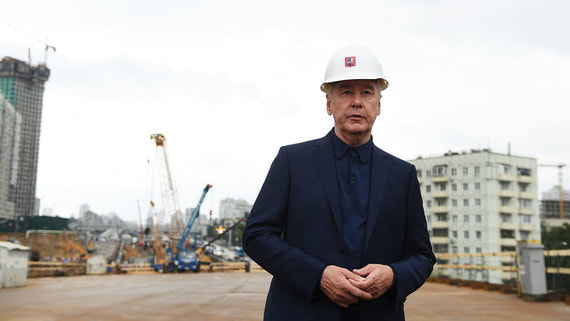
Nearly 5 million square meters have been erected. They claim there was only more housing in 1965.
In 2019, Moscow saw the commissioning of 4.96 million square meters of housing, according to Marat Khusnullin, Moscow’s Deputy Mayor for construction, in remarks to Vedomosti. This marks a 40% surge compared to the previous year. This level of housing construction has not been seen in Moscow since the 1960s when a nationwide program was implemented to address citizens’ housing issues, resulting in the construction of standard panel houses, popularly known as Khrushchev. The record was set in 1965, with approximately 5 million square meters commissioned in the capital. In 2007, 4.82 million square meters were commissioned under Yuri Luzhkov.
However, as noted by Andrey Kolochinsky, Managing partner of Vectorstroyfinance, comparing the 2019 results with previous years’ input volumes is not entirely accurate. In 2012, the area of Moscow increased 2.4 times due to the annexation of part of the territory of the Moscow region. Previously, statistics only accounted for projects within the old city boundaries. Last year, 1.1 million square meters were commissioned there.
Similar to half a century ago, the metropolitan authorities’ housing renovation program played a crucial role. Moscow Mayor Sergei Sobyanin announced it back in 2017, aimed at resettling about 1 million people from Khrushchev and other old houses. According to a representative of the capital’s construction complex speaking to Vedomosti, “The city’s renovation program is gaining momentum; for example, last year, 45 houses with an area of more than 1 million square meters were commissioned at the expense of the budget.” Future plans involve an increased role for the program, as stated by Roman Rodiontsev, Director of the Est-a-Tet Project Consulting Department. The construction complex indicates that 65 houses are scheduled for commissioning in 2020 under the renovation program.
Another contributing factor to the increased housing commissioning is the legislative changes that have prompted developers to expedite real estate entry, notes Khusnullin. The houses commissioned in 2019 began construction in 2016-2017. Back then, modifications were made to the project declaration design requirements, fund reservation procedures, and the process of registering apartment purchase agreements, leading to developers hurrying to obtain construction permits to continue operating under the previous regulations, as highlighted by Kolochinsky: “In 2016, a record number of construction permits were issued – projects for more than 10 million square meters of housing were approved.”
Maria Litinetskaya, Managing partner of Metrium, reflects on the total building area in Moscow, stating “If in 2016 the total building area in Moscow was about 10-11 million square meters, now it is up to 18.5 million square meters.” Litinetskaya attributes this growth to the active development of former industrial zones, which enabled developers to significantly increase construction compared to the era of sporadic development of small plots in the capital.
Kolochinsky aligns with Litinetskaya, highlighting that developers began vigorous development of industrial zones during this period, declaring projects with an area of 300,000-400,000 sq. m. He also sees the active construction of the urban transport network, particularly the MCC, which provided access to new locations, as an additional catalyst.
The need for housing continues to drive this remarkable surge in construction activity.
The population in Moscow has surged 3-4 times in recent years, as indicated by Alexey Perlin, CEO of the SMU-6 Investments development company. Furthermore, according to him, nowhere in Russia experiences such profitability in housing development as in Moscow. Hence, this sector continues to be enticing for investment.
There was a 24% decrease in the mean price of a perfume container in Russia
Cheaper mortgages have propelled demand, according to Anna Boim, Commercial Director of A101 Group of Companies. For instance, in 2018-2019, every other apartment was acquired through this means. The past year saw a record in mortgage issuance: 1.5 million loans amounting to 3 trillion rubles. This was attributed to the fact that mortgage rates have reached their lowest level since 2005 – standing at 8.7% for major lenders.
High housing construction rates cater to the interests of all market participants, as mentioned by Kolochinsky. Moscow authorities are striving to achieve the housing per person benchmarks of global megacities. Presently, the capital lags behind, with Moscow having 20 square meters of housing per resident, while in major megacities it is 1.5 times higher: 30 sq. m. Developers are keen on expediting construction, given the substantial cadastral value of land, which incurs additional costs if new plots are not developed promptly.
The weighted average housing price in new developments in the capital stands at 248,000 rubles per 1 sq. m (excluding the luxury segment), marking a 7.1% increase over the year, as per Rodiontsev from Est-a-Tet. Price escalation is attributable to various factors: depletion of lucrative lots, escalation of housing prices with construction readiness progression, and construction costs, including those associated with the shift to project financing. The introduction of substantial new housing volumes will lead to a reduction in secondary housing costs, as many clients will shift to “fresh” new developments, highlighted by Perlin from SMU-6 Investments.
How much are the Moscow authorities building – Graph




[…] Moscow achieves a record in housing development […]
[…] Moscow achieves a record in housing development […]
[…] Moscow achieves a record in housing development […]
[…] Moscow achieves a record in housing development […]